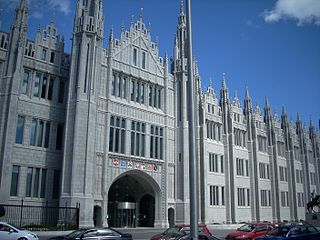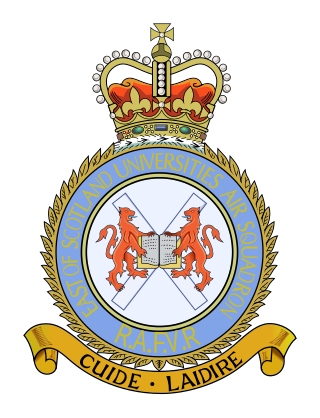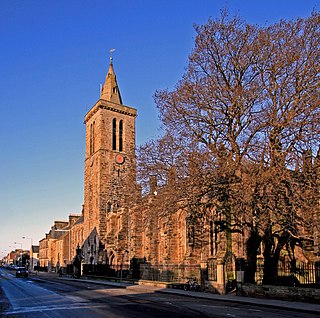
The University of St Andrews is a public university in St Andrews, Scotland. It is the oldest of the four ancient universities of Scotland and, following the universities of Oxford and Cambridge, the third-oldest university in the English-speaking world. St Andrews was founded in 1413 when the Avignon Antipope Benedict XIII issued a papal bull to a small founding group of Augustinian clergy. Along with the universities of Glasgow, Edinburgh, and Aberdeen, St Andrews was part of the Scottish Enlightenment during the 18th century.

The University of Dundee is a public research university based in Dundee, Scotland. It was founded as a university college in 1881 with a donation from the prominent Baxter family of textile manufacturers. The institution was, for most of its early existence, a constituent college of the University of St Andrews alongside United College and St Mary's College located in the town of St Andrews itself. Following significant expansion, the University of Dundee gained independent university status by royal charter in 1967 while retaining elements of its ancient heritage and governance structure.
The ancient universities of Scotland are medieval and renaissance universities that continue to exist in the present day. The majority of the ancient universities of the British Isles are located within Scotland, and have a number of distinctive features in common, being governed by a series of measures laid down in the Universities (Scotland) Acts 1858–1966. The Universities (Scotland) Act 1966 uses the term 'older universities' to refer to St Andrews, Glasgow, Aberdeen and Edinburgh. The same act provided for the independence from St Andrews of Dundee, which was then granted a similar form of governance under its royal charter.
The Officers' Training Corps (OTC), more fully called the University Officers' Training Corps (UOTC), are military leadership training units operated by the British Army. Their focus is to develop the leadership abilities of their members whilst giving them an opportunity to take part in military life whilst at university. OTCs also organise non-military outdoor pursuits such as hill walking and mountaineering. UOTC units are not deployable units nor are their cadets classed as trained soldiers until completion of MOD 1 training. The majority of members of the UOTC do not go on to serve in the regular or reserve forces.
The Coalition of Higher Education Students in Scotland (CHESS) was a body representative of students in Scotland, founded in 2001 by the Students' Associations of Aberdeen, Dundee, Edinburgh and St Andrews Universities, and Glasgow University's students' representative council.

The Lord Rector of the University of St Andrews is the president of the University Court of the University of St Andrews; the University Court is the supreme governing body of the University.

There are fifteen universities in Scotland and three other institutions of higher education that have the authority to award academic degrees.
In some Scottish universities a Master of Arts is the holder of a degree awarded to undergraduates, usually as a first degree. It follows either a three-year general or four-year Honours degree course in humanities or social sciences and is awarded by one of several institutions.
Legal education in the United Kingdom is divided between the common law system of England and Wales and Northern Ireland, and that of Scotland, which uses a hybrid of common law and civil law.
Conservative Future Scotland (CFS) was the youth wing of the Scottish Conservative Party.
The ancient university governance structure in Scotland is the organisational system imposed by a series of Acts of Parliament called the Universities (Scotland) Acts 1858 to 1966. The Acts applied to what were termed the 'older universities': the University of St Andrews, the University of Glasgow, the University of Aberdeen and the University of Edinburgh. Together these four universities are commonly referred to as the ancient universities of Scotland. Whilst the Acts do not directly apply to the University of Dundee, the same governance structure was ordained for use by that institution in its Royal charter.

Undergraduate gowns are a notable feature of academic dress for students at the ancient universities in Scotland.

The Dundee Law School is the law school of the University of Dundee in Scotland. It provides undergraduate and postgraduate teaching in Scots and English law, permitting students to qualify into all three United Kingdom legal jurisdictions. The law school traces its roots to the University of St. Andrews, and has placed in the top 15 law schools in the UK on the University League Tables. The school is based in the Scrymgeour Building—named for Henry Scrymgeour, a 16th-century legal philosopher from Dundee—while the Law Library is based in the libraries building, both on the university's main campus. The Law School is part of the wider School of Social Sciences, Humanities and Law at Dundee.

The East of Scotland Universities Air Squadron, commonly known as ESUAS, is a squadron within the Royal Air Force established in 2003 as an amalgamation of "East Lowlands Universities Air Squadron" (ELUAS) and "Aberdeen, Dundee and St Andrews Universities Air Squadron" (ADStAUAS). It is based at Leuchars Station, in Fife and flies a fleet of six Grob Tutor aircraft. ESUAS is the parent Squadron of 12 Air Experience Flight, who share the aircraft.
All types of architectural projects in Scotland are eligible, including new-build, regeneration, restoration, extensions and interiors.

The history of universities in Scotland includes the development of all universities and university colleges in Scotland, between their foundation between the fifteenth century and the present day. Until the fifteenth century, those Scots who wished to attend university had to travel to England, or to the Continent. This situation was transformed by the founding of St John's College, St Andrews in 1418 by Henry Wardlaw, bishop of St. Andrews. St Salvator's College was added to St. Andrews in 1450. The other great bishoprics followed, with the University of Glasgow being founded in 1451 and King's College, Aberdeen in 1495. Initially, these institutions were designed for the training of clerics, but they would increasingly be used by laymen. International contacts helped integrate Scotland into a wider European scholarly world and would be one of the most important ways in which the new ideas of humanism were brought into Scottish intellectual life in the sixteenth century.









